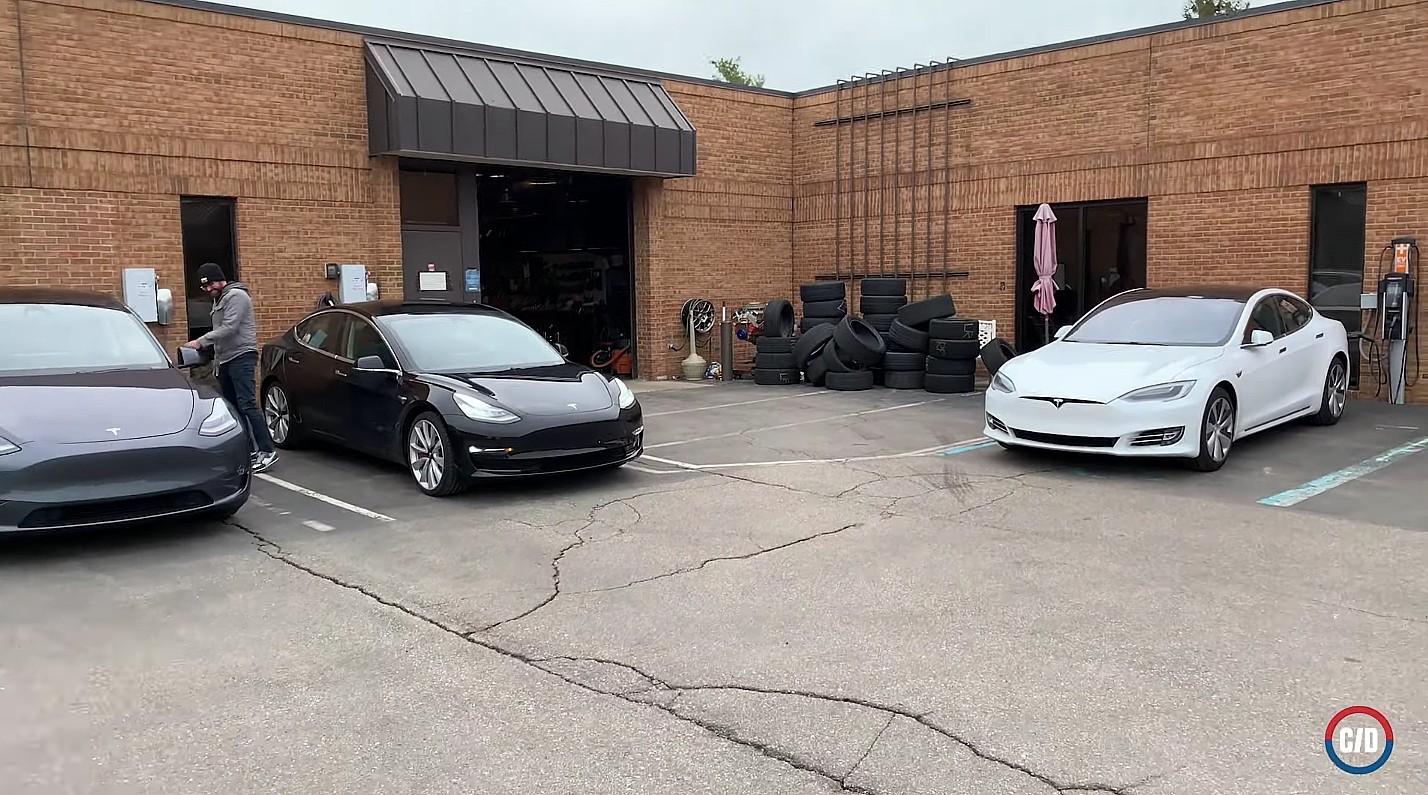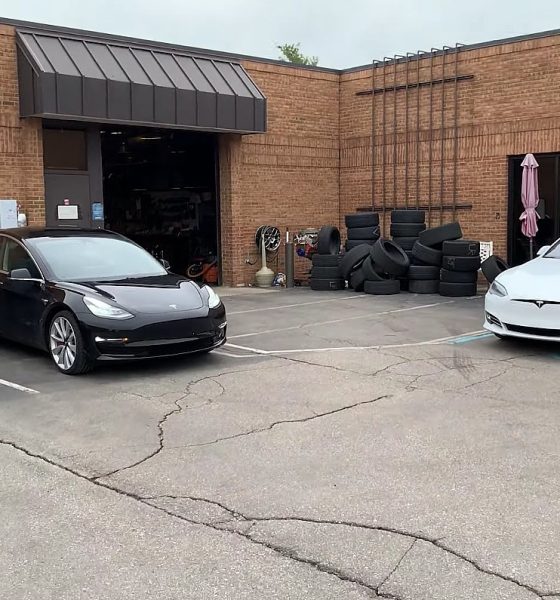

News
Tesla and its Supercharger Network dominate 11-way 1,000-mile EV test
An 11-way, 1,000-mile endurance test has proven that long trips with an electric vehicle in the United States are now possible, though those who are not driving Teslas may find themselves a bit challenged. These were the findings of motoring publication Car and Driver, which held a long-distance race between 11 EVs that are currently sold in the United States.
The vehicles that participated in the test were the Tesla Model S Long Range Plus, Tesla Model Y Performance, Tesla Model 3 Performance, Ford Mustang Mach-E, Porsche Taycan 4S, Kia Niro EV, Audi e-tron, Volkswagen ID.4, Volvo XC40 Recharge, Polestar 2, and Nissan Leaf Plus. Participants in the event, which were comprised of two-person teams, were given free rein to select their own route, provided that they hit checkpoints in Cincinnati; Athens, Ohio; Morgantown, West Virginia; Erie, Pennsylvania; and Ann Arbor.
Despite using apps like A Better Route Planner (ABRP), some teams immediately started hitting some challenges just a couple of dozen miles into the race. The team in the Nissan Leaf Plus, for example, made its first stop at a charging station just 23 miles into the race, reportedly as suggested by the ABRP app, but this resulted in them being the last group to arrive at a single ChargePoint DC fast charger in Lima, Ohio, behind three other teams. The team in the Audi e-tron eventually gave up their spot in the queue to look for another charging station, but they eventually returned after the other charger they were hoping to use turned out to be offline.
The non-Tesla EVs with longer range such as the Ford Mustang Mach-E and the Volkswagen ID.4 fared slightly better, driving longer distances before needing a charge. When the vehicles did need a charge, however, the teams ended up experiencing similar issues as their competitors. From single ChargePoint DC fast chargers in some locations to areas with only Level 2 chargers available, some of the teams in the race ended up wasting valuable time. This was especially true for the Ford Mustang Mach-E team, whose lead against its non-Tesla peers tricked down as slowly as the Level 2 stations it ended up using north of Morgantown.
In comparison, the Tesla Model S, Model 3, and Model Y teams went through the race without much issues, and a good reason for this was the Supercharger Network. With the rapid charging station being as robust as it is today, the trifecta of Teslas dominated the 1,000-mile race. The Model S Long Range completed the race in commanding fashion, and it was followed by the Model Y team, who beat the Model 3 team through some extra assertiveness. This all but proved that if drivers wish to conduct long road trips in an electric vehicle today, Teslas are still the way to go. The Supercharger Network is just that good.
Ultimately, the Tesla Model S completed the 1,000-mile run in 16:14, followed by the Tesla Model Y, which finished the race in 17:50. The Tesla Model 3 took third place with a 17:55 time. The rest of the competition arrived over the following hours. The Ford Mustang Mach-E, the electric vehicle hailed by Car and Driver as its 2021 EV of the Year, came in at fourth place with a total time of 20:31, followed by the Porsche Taycan 4S, which had a total time of 21:00. The Kia Niro EV, the Audi e-tron, and the Volkswagen ID.4 all took over 23 hours to complete the 1,000-mile run, and the Volvo XC40 Recharge needed 25:47 to finish the race. The Polestar 2 took a surprisingly long 26:52 to complete its run, while the Nissan Leaf Plus took a whopping 32:57 before it crossed the finish line.
Watch Car and Driver’s 11-way 1,000-mile EV test in the video below.
Don’t hesitate to contact us with news tips. Just send a message to tips@teslarati.com to give us a heads up.

Elon Musk
Starlink achieves major milestones in 2025 progress report
Starlink wrapped up 2025 with impressive growth, adding more than 4.6 million new active customers and expanding service to 35 additional countries, territories, and markets.

Starlink wrapped up 2025 with impressive growth, adding more than 4.6 million new active customers and expanding service to 35 additional countries, territories, and markets. The company also completed deployment of its first-generation Direct to Cell constellation, launching over 650 satellites in just 18 months to enable cellular connectivity.
SpaceX highlighted Starlink’s impressive 2025 progress in an extensive report.
Key achievements from Starlink’s 2025 Progress
Starlink connected over 4.6 million new customers with high-speed internet while bringing service to 35 more regions worldwide in 2025. Starlink is now connecting 9.2 million people worldwide. The service achieved this just weeks after hitting its 8 million customer milestone.
Starlink is now available in 155 markets, including areas that are unreachable by traditional ISPs. As per SpaceX, Starlink has also provided over 21 million airline passengers and 20 million cruise passengers with reliable high-speed internet connectivity during their travels.
Starlink Direct to Cell
Starlink’s Direct to Cell constellation, more than 650 satellites strong, has already connected over 12 million people at least once, marking a breakthrough in global mobile coverage.
Starlink Direct to Cell is currently rolled out to 22 countries and 6 continents, with over 6 million monthly customers. Starlink Direct to Cell also has 27 MNO partners to date.
“This year, SpaceX completed deployment of the first generation of the Starlink Direct to Cell constellation, with more than 650 satellites launched to low-Earth orbit in just 18 months. Starlink Direct to Cell has connected more than 12 million people, and counting, at least once, providing life-saving connectivity when people need it most,” SpaceX wrote.
News
Giga Nevada celebrates production of 6 millionth drive unit
To celebrate the milestone, the Giga Nevada team gathered for a celebratory group photo.

Tesla’s Giga Nevada has reached an impressive milestone, producing its 6 millionth drive unit as 2925 came to a close.
To celebrate the milestone, the Giga Nevada team gathered for a celebratory group photo.
6 million drive units
The achievement was shared by the official Tesla Manufacturing account on social media platform X. “Congratulations to the Giga Nevada team for producing their 6 millionth Drive Unit!” Tesla wrote.
The photo showed numerous factory workers assembled on the production floor, proudly holding golden balloons that spelled out “6000000″ in front of drive unit assembly stations. Elon Musk gave credit to the Giga Nevada team, writing, “Congrats on 6M drive units!” in a post on X.
Giga Nevada’s essential role
Giga Nevada produces drive units, battery packs, and energy products. The facility has been a cornerstone of Tesla’s scaling since opening, and it was the crucial facility that ultimately enabled Tesla to ramp the Model 3 and Model Y. Even today, it serves as Tesla’s core hub for battery and drivetrain components for vehicles that are produced in the United States.
Giga Nevada is expected to support Tesla’s ambitious 2026 targets, including the launch of vehicles like the Tesla Semi and the Cybercab. Tesla will have a very busy 2026, and based on Giga Nevada’s activities so far, it appears that the facility will be equally busy as well.
News
Tesla Supercharger network delivers record 6.7 TWh in 2025
The network now exceeds 75,000 stalls globally, and it supports even non-Tesla vehicles across several key markets.

Tesla’s Supercharger Network had its biggest year ever in 2025, delivering a record 6.7 TWh of electricity to vehicles worldwide.
To celebrate its busy year, the official @TeslaCharging account shared an infographic showing the Supercharger Network’s growth from near-zero in 2012 to this year’s impressive milestone.
Record 6.7 TWh delivered in 2025
The bar chart shows steady Supercharger energy delivery increases since 2012. Based on the graphic, the Supercharger Network started small in the mid-2010s and accelerated sharply after 2019, when the Model 3 was going mainstream.
Each year from 2020 onward showed significantly more energy delivery, with 2025’s four quarters combining for the highest total yet at 6.7 TWh.
This energy powered millions of charging sessions across Tesla’s growing fleet of vehicles worldwide. The network now exceeds 75,000 stalls globally, and it supports even non-Tesla vehicles across several key markets. This makes the Supercharger Network loved not just by Tesla owners but EV drivers as a whole.
Resilience after Supercharger team changes
2025’s record energy delivery comes despite earlier 2024 layoffs on the Supercharger team, which sparked concerns about the system’s expansion pace. Max de Zegher, Tesla Director of Charging North America, also highlighted that “Outside China, Superchargers delivered more energy than all other fast chargers combined.”
Longtime Tesla owner and FSD tester Whole Mars Catalog noted the achievement as proof of continued momentum post-layoffs. At the time of the Supercharger team’s layoffs in 2024, numerous critics were claiming that Elon Musk was halting the network’s expansion altogether, and that the team only remained because the adults in the room convinced the juvenile CEO to relent.
Such a scenario, at least based on the graphic posted by the Tesla Charging team on X, seems highly implausible.







